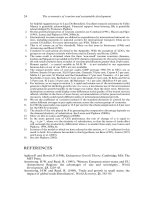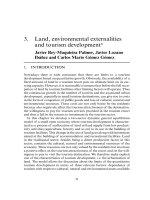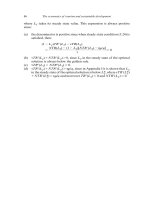THE ECONOMICS OF MONEY,BANKING, AND FINANCIAL MARKETS 151
Bạn đang xem bản rút gọn của tài liệu. Xem và tải ngay bản đầy đủ của tài liệu tại đây (36.69 KB, 1 trang )
CHAPTER 6
A PP LI CATI O N
The Risk and Term Structure of Interest Rates
119
Effects of the Bush Tax Cut on Bond
Interest Rates in the United States
The Bush tax cut passed in 2001 scheduled a reduction of the top income tax
bracket from 39% to 35% over a ten-year period. What is the effect of this income
tax decrease on interest rates in the municipal bond market relative to those in the
U.S. Treasury bond market?
A supply and demand analysis similar to that in Figure 6-2 provides the answer.
A decreased income tax rate for wealthy people means that the after-tax expected
return on tax-free municipal bonds relative to that on U.S. Treasury bonds is lower
because the interest on Treasury bonds is now taxed at a lower rate. Because municipal bonds now become less desirable, their demand decreases, shifting the demand
curve to the left, which lowers their price and raises their interest rate. Conversely,
the lower income tax rate makes U.S. Treasury bonds more desirable; this change
shifts their demand curve to the right, raises their price, and lowers their interest rates.
Our analysis thus shows that the Bush tax cut has caused interest rates on
municipal bonds to rise relative to interest rates on Treasury bonds. With the possible repeal of the Bush tax cuts that may occur with the Obama administration,
this analysis would be reversed. Higher tax rates would raise the after-tax expected
return on tax-free municipal bonds relative to Treasuries. Demand for municipal
bonds would increase, shifting the demand curve to the right, which would raise
their price and lower their interest rate. Conversely, the higher tax rate would
make Treasury bonds less desirable, shifting their demand curve to the left, lowering their price, and raising their interest rate. Higher tax rates would thus result
in lower interest rates on municipal bonds relative to the interest rate on Treasury
bonds.
Summary
In general, the risk structure of interest rates (the relationship among interest rates
on bonds with the same maturity) is explained by three factors: default risk, liquidity, and the income tax treatment of the bond s interest payments. As a bond s
default risk increases, the risk premium on that bond (the spread between its interest rate and the interest rate on a default-free Canadian government bond) rises.
The greater liquidity of Canada bonds also explains why their interest rates are
lower than interest rates on less liquid bonds. If a bond has a favourable tax treatment, as do municipal bonds in the United States whose interest payments are
exempt from federal income taxes, its interest rate will be lower.
TE RM ST RU CTU RE O F I N TE REST RAT ES
We have seen how risk, liquidity, and tax considerations (collectively embedded
in the risk structure) can influence interest rates. Another factor that influences the
interest rate on a bond is its term to maturity: bonds with identical risk, liquidity,
and tax characteristics may have different interest rates because the time remaining to maturity is different. A plot of the yields on bonds with differing terms to
maturity but the same risk, liquidity, and tax considerations is called a yield curve,
and it describes the term structure of interest rates for particular types of bonds,
such as government bonds. The Financial News box Yield Curves shows several









